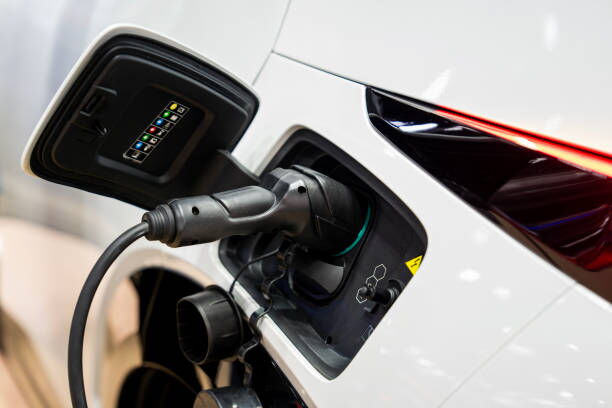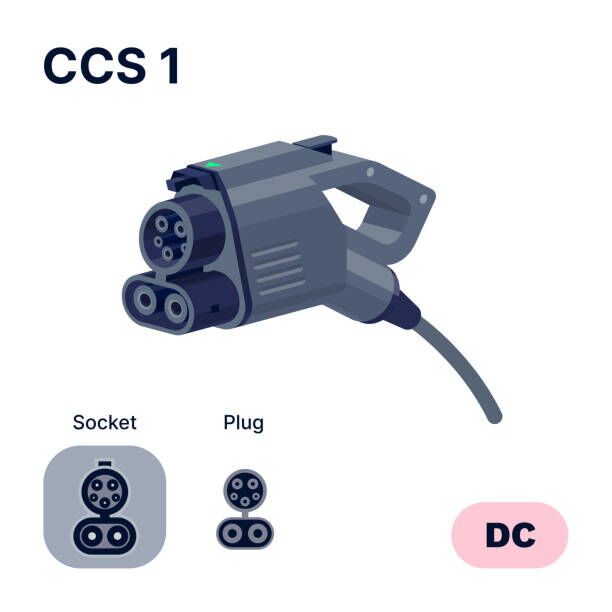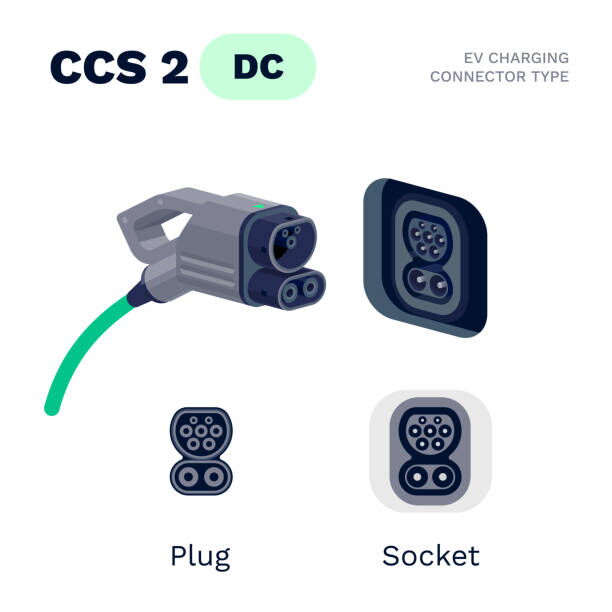As electric vehicles (EVs) continue to accelerate into the mainstream, one of the most important aspects for drivers is the ability to charge conveniently and quickly. Charging standards have evolved significantly in recent years, aiming to ensure compatibility, efficiency, and safety across a wide range of vehicles and infrastructure. Among the most widely discussed and adopted standards is CCS — the Combined Charging System.
The name “Combined Charging” is literal: CCS integrates DC fast-charging capability into an existing AC charging connector. By adding two extra DC pins to the base design, CCS enables a single port on the vehicle to handle both slower AC charging and ultra-fast DC charging. This approach offers flexibility, allowing EV owners to plug into home chargers, public AC stations, and high-powered DC fast chargers without needing multiple different charging inlets.

However, CCS comes in two main variations:
CCS1 (Combo 1): Primarily used in North America and South Korea, based on the SAE J1772 (Type 1) AC plug with two added DC pins.
CCS2 (Combo 2): Predominantly used in Europe, Australia, New Zealand, and much of the Asia-Pacific region, extending the IEC 62196 (Type 2) plug with additional DC pins.
Although they share the same underlying principle, CCS1 and CCS2 have distinct physical designs, regional adoptions, and technical specifications. Understanding these differences is essential for EV owners, charging station operators, and manufacturers aiming to navigate a rapidly expanding and increasingly interconnected EV ecosystem.
While both standards serve the same fundamental purpose — combining AC and DC charging into a single vehicle inlet — their design, technical capabilities, and market presence diverge in notable ways.
Originates from the SAE J1772 (Type 1) connector.
Primarily supports single-phase AC charging, reflecting the electrical infrastructure of North America.
Adds two large DC power pins below the Type 1 interface. These pins carry high-voltage DC current during fast charging sessions.
The result is a compact, easy-to-handle connector, optimized for the single-phase AC grids common in the United States and Canada.

Based on the IEC 62196 Type 2 connector, commonly called the “Mennekes” plug in Europe.
Supports both single-phase and three-phase AC charging, making it more versatile in regions with three-phase grids.
Integrates two additional DC pins — typically positioned below the AC section — enabling high-power DC fast charging.
Its design allows for higher current-carrying capacity, making it better suited for ultra-fast charging applications in public networks.
Visual Difference:
From a glance, CCS1’s upper portion has a smaller round AC section (Type 1), while CCS2’s upper portion is more oval, with more pins for three-phase compatibility.

Voltage: Both CCS1 and CCS2 support DC charging voltages typically up to 920 V under most modern implementations, aligning with high-voltage battery systems found in many next-generation EVs.
Current: CCS1 typically handles up to 200 amps in real-world applications, whereas CCS2 can accommodate up to 350 amps thanks to its more robust physical contacts and cable cooling options. This gives CCS2 a potential advantage in reducing charging times for high-capacity batteries.
Under optimal conditions, both CCS1 and CCS2 can theoretically deliver up to 350 kW. However, achieving these speeds depends on the EV’s battery acceptance rate, charger capabilities, and cable cooling technology.
For AC charging, CCS1 is usually paired with Level 2 charging (up to 19.2 kW in North America), while CCS2 supports both Level 2 and three-phase AC charging, reaching up to 43 kW AC in some public stations.
Both versions use the PLC (Power Line Communication) protocol for data exchange between the EV and charging station. This allows advanced functions such as load management, charging scheduling, and potentially bidirectional charging (Vehicle-to-Grid, or V2G) when supported by hardware and regulations.
Primary Regions: United States, Canada, South Korea.
Market Drivers: North American automakers (such as Ford, General Motors, and Rivian) and the existing SAE J1772 AC standard.
Infrastructure: Most public fast-charging stations in the U.S. and Canada — especially those in networks like Electrify America and EVgo — include CCS1 plugs alongside CHAdeMO (for older Nissan LEAF models) and Tesla’s NACS adapters.
Primary Regions: European Union, United Kingdom, Australia, New Zealand, and parts of Asia (including India and Singapore).
Market Drivers: The European Commission’s directive mandating CCS2 as the standard connector for public charging stations has ensured widespread adoption.
Infrastructure: Almost all new public fast chargers in Europe include CCS2 connectors, often alongside AC Type 2-only sockets for slower charging.
|
Charging Standard |
Maximum Charging Speed |
Efficiency |
|
CCS1 |
50kW - 150 kW |
90% - 95% |
|
CCS2 |
50kW - 350 kW |
90% - 95% |
|
CHAdeMO |
62.5kW - 400 kW |
90% - 95% |
|
Tesla Supercharger |
250 kW |
90% - 95% |
Fast Charging: CCS1 supports high-power DC charging, enabling electric vehicles to recharge large amounts of energy quickly and significantly reduce charging time.
Versatility: It accommodates multiple charging modes, making it suitable for diverse user needs—from home AC charging to public fast charging stations.
Innovative Connector Design: Featuring a J1772 connector on top for AC charging and two additional DC pins below for rapid charging, CCS1 ensures backward compatibility with existing J1772 AC chargers.
Widespread North American Adoption: CCS1 is the leading charging standard across the U.S. and Canada, embraced by major automakers like General Motors, Ford, and BMW for their electric vehicle lineups.
Strong Future Outlook: With the rapid growth of the EV market, CCS1 infrastructure continues to expand, offering increased convenience and accessibility for users.
Uneven Infrastructure: The availability of CCS1 charging stations remains limited in certain regions, particularly in rural and remote areas, which restricts the ease of long-distance travel.
Compatibility Issues: Not all electric vehicles support CCS1; some models still rely on alternative standards like CHAdeMO, potentially causing inconvenience during charging.
Cost Considerations: Building and maintaining CCS1 charging stations can be expensive, which may translate into higher charging costs for users.
Charging Process Complexity: Some users may find the variety of charging modes and connector interfaces confusing and require time to become familiar with the system.
Regional Limitations: CCS1 is predominantly used in North America and has limited adoption in Europe and Asia, making it challenging for CCS1-equipped EVs to find compatible chargers when traveling internationally.
Higher Charging Power: With fast charging capabilities exceeding 350 kW, CCS2 enables ultra-fast charging on public networks like IONITY across Europe.
Optimized Design: The simpler CCS2 interface enhances user experience by making operation more intuitive and straightforward.
Connector Design: CCS2 features a Type 2 (Mennekes) connector for AC charging on top—a standard widely used across Europe—combined with two additional DC pins at the bottom for rapid DC charging.
Widespread Adoption in Europe and Beyond: CCS2 is the dominant charging standard throughout Europe and is embraced by leading automakers including Volkswagen, Audi, Porsche, and Tesla’s European models.
Limited Infrastructure in Remote Areas: Although CCS2 is increasingly common in cities, charging stations remain scarce in rural and remote locations.
Device Compatibility: Not all electric vehicles support CCS2, and some older models may require adapters to use CCS2 chargers.
Higher Installation Costs: CCS2 charging stations generally involve greater construction and maintenance expenses compared to CCS1, which can impact charging prices.
User Familiarity: Some users may be unfamiliar with the CCS2 standard and need time to learn how to navigate its charging process and interface.
Limited Support in North America: CCS2 is not widely adopted in the U.S. and Canada, so European or Asian EVs equipped with CCS2 connectors may face difficulties finding compatible chargers without using adapters.
Choosing the right connector standard is not typically an active decision for individual EV owners — it is determined by the EV’s manufacturer based on the target market. However, for businesses, fleet managers, or those importing/exporting EVs, understanding these standards is critical.
Key Considerations:
Always match the charging connector to the vehicle’s inlet. Using an incompatible connector will require an adapter, which may not always be available for DC fast charging.
North America / South Korea: CCS1 dominates.
Europe / Australia / New Zealand / Asia-Pacific: CCS2 is the norm.
If high-speed charging is critical and you have access to a three-phase grid, CCS2’s higher current capacity offers advantages.
For most North American drivers, CCS1 provides sufficient charging speed given grid limitations.
With charging technology evolving rapidly, consider whether your region is adopting alternative standards — such as Tesla’s NACS in North America — and whether your EV can adapt to them.
Although CCS1 and CCS2 are regionally divided, there is increasing pressure toward interoperability. Charging networks are beginning to install multiple connector types at the same station to accommodate a wider range of vehicles. Additionally, adapter technologies are improving, allowing cross-standard charging in certain circumstances.
In Europe, CCS2’s integration into both AC and DC public charging has made it a future-proof choice. In North America, the situation is more fluid, with Tesla’s NACS connector gaining ground and many automakers planning to adopt it alongside CCS1.
CCS1 and CCS2 share the same mission: to make EV charging simpler, faster, and more flexible. They embody the “combined” concept by merging AC and DC charging into a single, user-friendly interface. While their regional differences in design and technical capacity reflect the diversity of global electrical infrastructure, their underlying compatibility ensures that both will remain key players in the EV charging landscape for years to come.
For EV owners, understanding whether their car uses CCS1 or CCS2 is essential when planning trips, installing home chargers, or choosing public charging stations. For businesses and policymakers, aligning infrastructure with the appropriate standard ensures accessibility, promotes EV adoption, and helps build a truly global charging network.
As the EV industry evolves, both CCS1 and CCS2 may eventually coexist alongside emerging technologies, offering drivers a world where charging is as universal and effortless as refueling a gasoline car once was.